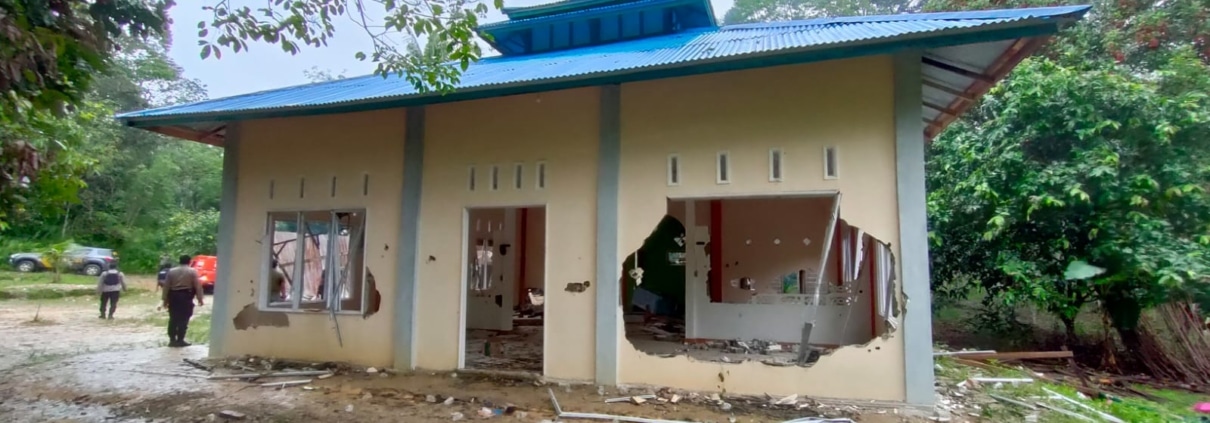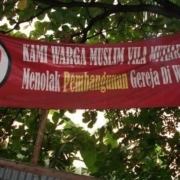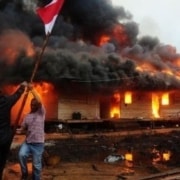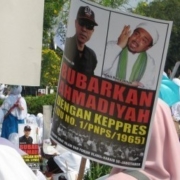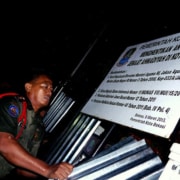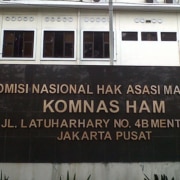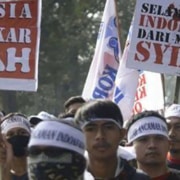
The Miftahul Huda Mosque in Balai Harapan village, following the attack on 3 September 2021.
On 3 September 2021, several dozen members of a group calling itself the “Muslim Community Alliance” (Aliansi Umat Islam) burned down the mosque of the Ahmadiyah community in Balai Harapan village, Sintang, West Kalimantan.
Ahead of the attack, the Muslim Community Alliance had referred to a notorious 2005 religious opinion, or fatwa, published by the Indonesian Council of Ulama (MUI) that described the minority Islamic sect Ahmadiyah as a deviant sect “outside Islam” and called on the government to ban it.
In mid-August, the Muslim Community Alliance had issued the district government with an ultimatum, calling on it to act against the Ahmadiyah community within three days. Responding to this pressure, on 14 August, the district government forcibly closed the Ahmadiyah mosque. But the Muslim Community Alliance was still not satisfied, and destroyed the mosque and an Ahmadiyah-owned building next to it.
Following the attack, the Sintang district government continued to bend to pressure from the Muslim Community Alliance, and asked the Ahmadiyah community to tear down the remains of the mosque. In January, the district government removed all Ahmadiyah signage, took down the mosque’s spire, and converted it into a residential home.
As in many other cases affecting religious minorities, the attackers escaped with mild sentences. On 6 January 2022, the Pontianak District Court sentenced 21 attackers to just four months and 15 days in prison. Time already served in detention meant the attackers were only detained for about two additional weeks after sentencing.
West Kalimantan is an ethnically and religiously diverse society with large populations of indigenous Dayak, ethnic Malay, ethnic Chinese, and Madurese migrants. According to one government measure, the province has previously ranked among the most “tolerant” provinces in Indonesia. Despite this ranking, following the attack, few civil society organisations (CSOs) in the province seemed willing to publicly defend the rights of the Ahmadiyah community.
A week after the mosque attack, I travelled to Sintang with colleagues from Setara Institute and Yayasan Satu Keadilan to investigate the case. It quickly became clear to us that many West Kalimantan residents were reluctant to show solidarity with the Ahmadiyah community, fearing it could lead to religious or ethnic conflict.
These fears are understandable, given the long history of ethnic violence in West Kalimantan. While definitions of conflict vary, one scholar noted there were 16 major ethnic conflicts between 1950 and 1999: one Dayak-ethnic Chinese conflict in 1967 and 15 between Dayaks and Madurese. These conflicts were often triggered by trivial matters, but on several occasions spiralled out of hand, with devastating consequences.
The most prominent example is the 1999 Sambas conflict. While the conflict reportedly began with a petty dispute between Malays and Madurese, the Dayaks soon joined on the side of the Malays. This conflict led to more than 1,000 people being killed and nearly 4,000 houses destroyed. More than 50,000 ethnic Madurese were displaced.
A complicating factor in West Kalimantan is that ethnicity is closely intertwined with religion. In West Kalimantan, Malays are mostly Muslim, Dayak are mostly Christian, while the ethnic Chinese are usually Christian, Buddhist or Confucian. In fact, religion is such a dominant identifier in the region that a Dayak or ethnic Chinese person who converts to Islam is often considered to “become Malay”.
These factors help explain why CSOs in West Kalimantan appeared reluctant to respond to the Sintang incident. Some individuals expressed sympathy privately to the Ahmadiyah followers, but there was no strong interfaith movement, and very few coordinated efforts from civil society to promote social cohesion following the conflict. This contrasts with the situation on Java, where attacks on religious minorities have often prompted interfaith groups and pro-tolerance CSOs (such as the Setara Institute, the Wahid Institute, Elsam, Gusdurian, the Indonesian Legal Aid Foundation and more) to speak up on behalf of minorities.
Indeed, West Kalimantan residents told me that some locals were criticised for condemning the attack on the Ahmadiyah mosque. For example, one informant told me her Muslim friend was pressured into silence by his friends after speaking up for the rights of Ahmadiyah followers, over fears it might inflame ethnic tension with other Muslims of different ethnicity. She even asked me to conceal the Muslims’ ethnicities, indicating just how sensitive these issues are in West Kalimantan.
Other non-Muslims saw the attack an internal problem among Muslims. They were reluctant to speak up over concerns that they could be seen as interfering in local Muslims’ affairs.
Months after the incident, some religious leaders and individuals concerned with intolerance initiated an informal interfaith dialogue, discussing the issue broadly in peacebuilding terms, rather than solely focusing on the rights of the Ahmadiyah community. But these efforts at dialogue were met with intimidation by the Muslim Community Alliance. Muslims involved in the dialogue were accused of taking sides with Ahmadiyah followers. One even received a death threat. Weak coordination and the reluctance of any one organisation or individual to take a leadership role also obstructed peacebuilding efforts.
The Ahmadiyah community is attempting to move on from the incident. They greet their neighbours and make efforts to interact with them, but the scars of the conflict remain. Journalist Dian Lestari reported that six months after the incident, many Ahmadiyah followers are still deeply traumatised by the conflict. Some Ahmadiyah children have been bullied by their peers, while some Ahmadiyah-owned businesses have faced local boycotts.
The attack on the Ahmadiyah mosque in Sintang and its aftermath has made it clear that there is still much more work to be done to support peacebuilding and prevent future tension and conflict. Durable peace is only possible when it is locally built and owned. Local civil society and interfaith movements have a central role to play in peacebuilding and promoting social cohesion.
However, as Law No. 7 of 2012 on Management of Social Conflict makes clear, the government also has a responsibility to support the psychological and economic recovery of the Ahmadiyah followers (Article 38(1)(2)). While some officials have made public efforts to counter stigma, the government must also ensure there is safe space for civil society to strengthen public awareness and promote dialogue. In particular, it must ensure action is taken against those who threaten peacebuilding activists or break up efforts to promote dialogue.
Dialogue – inter-ethnic, inter-faith, and intra-faith (for example, between Ahmadiyah and mainstream Muslims) – matters. It can reduce stigma and help diverse groups understand each other better, and recognise that many groups in West Kalimantan have suffered from past conflicts. In other regions, including West Java and Lombok, dialogue has been effective in helping people who persecuted or were indifferent to the rights of minorities to empathise with them, and sometimes even act to protect their rights.
Dialogue can take informal forms, such as group sport activities, or collaboration on other local social causes. But whatever shape it takes, it needs to be ongoing, even at times when society seems “harmonious”. The impacts of dialogue will take time to be felt, but it is essential for sustainable peace.
Influential local government, religious and civil society figures also have important roles to play in supporting these efforts. For example, village leaders in Balai Harapan previously warned residents to not be swayed by identity politics, and encouraged them to allow the construction of the Ahmadiyah mosque in their village back in March 2021. Prominent local government, religious and civil society figures can play an important leadership role and strengthen coordination among interfaith groups.
Finally, external actors can also support local peacebuilding efforts. National CSOs can conduct policy advocacy on peacebuilding at the national level. They can also work with local CSOs to continue strengthening grassroots awareness about peace and the rights of minorities.
Above all, they need to assert that violence should be the concern of all Indonesians, regardless of religion or ethnicity. When people express support for the rights of Ahmadiyah followers or other minorities facing violence, it should not be viewed as taking sides in a conflict or interfering in another religion’s internal affairs but simply as defence of the equal rights they all share as citizens of Indonesia.


